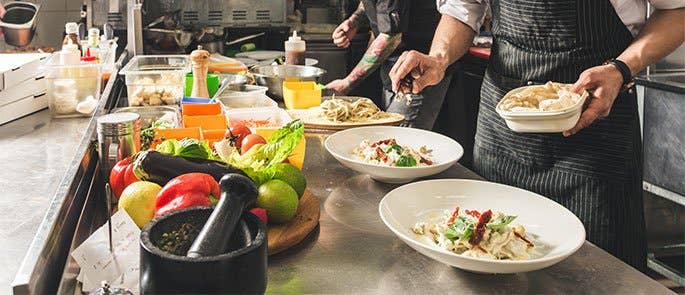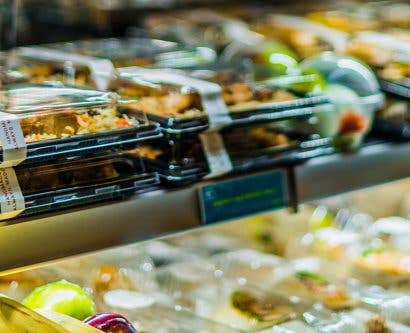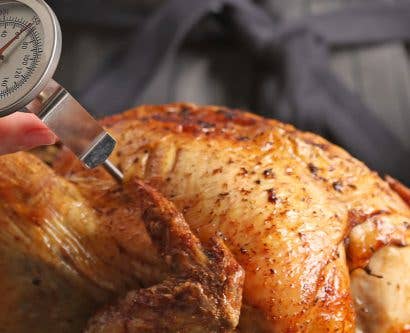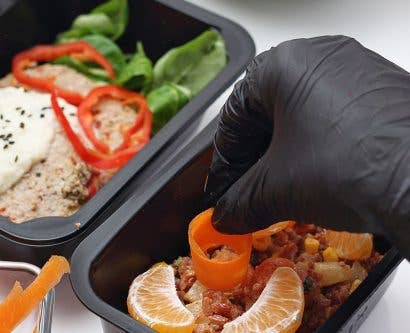10 Ways to Reduce Food Waste in Your Restaurant
Across the hospitality and food service sector, 1.1 million tonnes of food is thrown away each year. To make matters worse, 75% of that food is perfectly edible. Food waste is extremely harmful to the environment as it wastes resources and generates dangerous greenhouse gases. It’s not just our planet that suffers though. Guardians of Grub, a government initiative that focuses on reducing food waste in the hospitality industry, estimates that the 1.1 million tonnes of food wasted costs the industry a monumental £3.2 billion each year.
As the hospitality sector continues to contend with post-pandemic changes, the cost-of-living crisis and rising supply and energy prices, the cost of food waste is something they simply cannot afford. Whilst it can be difficult to know where to start when tackling food waste, the adoption of simple sustainable practices can drastically reduce the financial and environmental impact of food waste.
In this article we will outline why food waste is an issue for restaurants and why it is important to reduce the waste that you generate. We will also discuss common causes of food waste and provide tips to help you reduce food waste in your business.
Why is Food Waste a Problem?
Food waste can feel like an inevitable by product of working in the hospitality industry. Food waste is generated in hospitality much in the same way it is domestically and when you’re serving hundreds of people a day, vast amounts of food waste is to be expected. Nevertheless, despite its categorisation as an ‘unavoidable evil,’ food waste is in fact a significant problem for the hospitality sector; in terms of both the harmful greenhouse gases that it generates and its negative effect on profitability.
Food waste has a catastrophic impact on the environment. When food is left to rot in landfills it releases methane, a greenhouse gas that is 84 times more potent than carbon dioxide and has 28 times the global warming potential. Moreover, when edible food is thrown away, the resources used to rear, grow, process and transport that food, such as water, energy and labour, are wasted. The water footprint of the total annual food waste in the UK is estimated to be around 5.4 billion cubic metres. A 2024 government report on food waste found that the hospitality and food service sector generated 10% of the total food wasted in 2021. This equates to 540 million cubic metres of water wasted by the hospitality and food service sector alone, roughly the same as 216,000 Olympic sized swimming pools.

Food waste is also an avoidable financial burden for the sector. In 2019 the hospitality industry had an economic output of £59.3 billion, equating to roughly 3% of the total UK economic output. By 2020 that figure had fallen by 42% and though higher in 2021, it was still 21% lower than 2019. The hospitality sector was one of the hardest hit by covid due to socialising restrictions and lockdowns. Though the industry has fought tooth and nail to regain stability, it continues to battle with the fallout of covid, rising operating costs and a cost-of-living crisis that is impacting custom. Food waste can then be seen as an additional, yet avoidable, cost that many in the sector cannot afford.
WRAP estimates that food waste costs the hospitality industry £3.2 billion every year, an average of £10,000 per outlet, per year. It can be hard to imagine how this much money is wasted, especially in an industry in which finances are already so tight for many. However, when one remembers that waste is cumulative it becomes much easier to see how frequent instances of over-ordering, overproduction and human error can result in such vast amounts of waste, both in terms of food and lost profit.
Causes of Food Waste in Restaurants
As mentioned above, food waste in restaurants can be generated in similar ways to households and is often cumulative, meaning that seemingly insignificant waste such as the odd vegetable skin or some fat trimmings, add up to create vast amounts of waste. However, there are causes of food waste that are unique to restaurants and the hospitality industry.
Causes of food waste across the sector include:
- Consumer Plate Waste – Much like in a domestic setting, waste is generated when unfinished food on the plate is thrown away. Large portion sizes or the inability to take leftovers home are the main causes of this kind of waste.
- Over-ordering and Spoilage – Many in the hospitality industry plan ahead and prep ingredients ready for busy days as it is often better to be over-prepared than under-prepared. Subsequently they may end up over-ordering ingredients and supplies to avoid potential delays and to ensure their kitchens remain well stocked. However, if for whatever reason the food doesn’t sell, restaurants can be left with a surplus which they then need to repurpose before it spoils and has to be thrown away.
- Trimmed or Peeling Waste – As with household waste, this waste is generated when preparing food and includes vegetable peels, fruit skins and fat trimmings. As restaurants can end up serving hundreds of people a day, they generate significantly more of this waste due to the preparation of large quantities of food.
- Menu Changes – Menu changes can be an exciting time for a restaurant and bring with it the opportunity to entice new customers. However, these changes can lead to unused or unwanted inventory going to waste if the new menu is drastically different from previous menus.
- Overproduction – Like over-ordering, overproduction is often the result of a desire to be well prepared. However, restaurants may end up preparing more food than necessary and in a manner that makes it difficult to use in other dishes. This then leads to food waste as the pre-prepared food is not used.
The list above is not exhaustive and food waste in the hospitality sector is influenced by a wide variety of factors such as the type of establishment and the food served. However, identifying the ways in which the sector uniquely generates waste is the first step to reducing it. It is also important to remember that this waste is not exclusive to bricks and mortar businesses as mobile caterers also generate significant amounts of food waste. Whilst mobile businesses often have limited space, so may be less susceptible to over-ordering or overproduction, consumer plate waste and preparation waste still contribute to the generation of vast amounts of food waste.

How to Reduce Food Waste in Restaurants
Douglas McMaster, owner of the world’s first zero waste restaurant Silo argues that ‘waste is a failure of the imagination.’ The hospitality industry is undeniably one of creative innovation and avant-garde experimentation. This creativity has led to the development of awe-inspiring dishes and news worthy menus and can also be applied to the reduction of food waste. Tackling food waste can be an exciting and creative thought exercise, just like developing a new menu and shouldn’t be treated like an arduous, unimportant task.
Below you will find 10 ways to reduce food waste. Not every option will be viable for your business, however don’t be afraid to use your imagination and tweak and adapt suggestions to find what works best for you.
Proper Storage 
Food lasts longer when it is stored correctly. Ensure that your fridges and freezers are running at the right temperature and that food is stored in the right position, for example keeping high risk foods stored on lower shelves. Storing food in the right condition is vital to preserving quality and preventing the growth of pathogenic bacteria, both of which can quickly lead to food waste. You should also ensure that all food is labelled correctly, especially if it has been decanted into a different container for storage. Plastic tubs filled with nondescript food can sit unnoticed in the back of your walk-in for months, until an unsuspecting member of staff spots it during the lunch rush and it has to be thrown away. Instead, make sure you implement a clear labelling system that details all key information such as the expiration date, a product description and any relevant allergen labelling. This makes it easier to keep track of what you have and what needs using.
Seasonal and Smart Menus 
Using seasonal ingredients in menus can reduce food waste and the cost of supplies. Buying fruits and vegetables when they are in season tends to be cheaper as they are abundant and more readily available. They also have a lower carbon footprint as it is their natural growing season and they don’t require as much transportation. By using seasonal ingredients you are committing to using them within a certain time frame. Since this time frame is limited, it encourages you to find creative ways to make the most of the ingredients while you can, reducing the amount of food that is wasted since it will potentially not be readily available again for another year. A well planned menu is integral to reducing food waste and a smart menu enables you to have a more creative approach to this. You can make your menu ‘smart’ by developing dishes that use the same ingredients in similar ways. This ensures that should you over prepare ingredients, they can be used in different dishes rather than going to waste.
Staff Training 
By law, all food handlers must be trained in food safety. Training staff on how to properly and safely handle, store and prepare food helps to reduce waste generated through human error. Preparation waste is one of the main causes of food waste in restaurants and the hospitality industry as a whole. Therefore, training staff in the importance of reducing food waste will enable them to prepare food in a way that creates as little waste as possible. Training staff is more than dictating to them what they should and shouldn’t do. It’s a chance to explain the rationale behind certain practices. If staff are made aware of why reducing food waste is so important and how their actions can directly affect its generation, they will be better able to make sustainable choices that reduce food waste.
Engage Customers 
Environmentalism is no longer just a buzz word intended to guilt people into walking more and driving less. Social awareness around the importance of protecting the planet continues to grow and has led to tangible changes in consumer behaviour. A 2024 YouGov report found that 60% of Britons agree that climate change is the biggest threat to civilisation. The report also found that 64% of British consumers are willing to pay up to 10% more for more sustainable options. By being open about your desire to reduce food waste, you can engage with these changes in attitudes and appeal to consumers who are making more sustainable choices. Moreover, you can then encourage those same customers to make environmentally friendly choices when visiting you, such as taking home leftovers, sharing larger meals to avoid plate waste or trying a sample before committing. Reducing food waste is just one way in which you can improve sustainability in your restaurant. However, regardless of which methods you choose to adopt, engaging your customers can help you to appeal to a broader range of people and grow your consumer base.
Adaptable Portion Sizes 
Customer leftovers account for a significant proportion of the food waste generated by the hospitality industry. Offering different portion sizes helps to reduce the amount of food left to waste and allows customers to make better informed decisions regarding how much food they will be able to consume. There is also a cost implication that will appeal to many as smaller portions can be made cheaper which also enables consumers to try more items from your menu. Providing the option to have a side dish as a main, or change a main into a side, gives consumers more control over how much food they order and in turn, how much food is wasted. You can also apply this thinking to sides or garnishes and provide customers with the option to remove a side or garnish that they know they won’t eat. One way to reduce food waste is to reduce the number of items that you have on your menu. However, if this is not viable for your business or simply a change you do not want to make, adaptable or smaller portion sizes can help to reduce waste in a similar way without compromising the variety on your menu.
Efficient Ordering 
Over-ordering is another notable cause of food waste in the industry. As such, ordering ingredients in a more efficient manner is a good way to reduce waste. Whilst it can be tempting to stock up or buy in bulk if your supplier has a good deal on, doing so can leave you with more food than you need which inevitably ends up being wasted. Instead, ensure that you only purchase the ingredients that you know your business will use. Keep an inventory of stock so that you know exactly which ingredients you have ready to hand at all times. Having a detailed list of what ingredients you have stored where, as well as their expiration date helps to prevent food being forgotten and going to waste, or being ordered in excess and leaving you with more than you can use before it spoils. Another key part of efficient ordering is inspecting your deliveries when they arrive. When deliveries arrive it is important to check items, both for quality and signs of damage and to check that you are only accepting what you actually ordered and what you actually need. Rejecting anything that is visibly spoiled, damaged, or has been transported at the incorrect temperature, will ensure you do not accept food that will spoil quicker than you can use it.
Stock Rotation 
Poor stock organisation can lead to food waste as it makes it harder to keep track of your stock. This can lead to over-ordering as you buy more stock than needed. Introducing a simple system such as First In, First Out (FIFO) allows you to rotate stock, ensuring that older items are kept at the front and are therefore used first. The process of rotating your stock enables you to keep track of what you have and strategically position ingredients so that those that will expire soon are used first.
Compost 
When food is composted rather than being sent to a land fill, the organic matter is turned into valuable fertiliser. This fertiliser is nutrient rich and great for gardening and growing your own ingredients. This may not be a viable option for all businesses, however, composting food waste is a great way to divert it from landfills and give it a new lease on life. You may choose to set up a compost bin and use the compost produced to grow herbs for your restaurant, or get in touch with a local allotment and see if they have a communal compost bin that they would let you contribute to. Composting is more than leaving food to rot in the garden and you need to ensure that the conditions are suitable for the microorganisms to break down any organic material. However, once you have the basics mastered, composting can be a simple way to turn food waste into something useful.
Repurpose Preparation Leftovers 
Preparation leftovers include things such as animal bones, vegetable peels and fruit skins and these leftovers need not head straight for the bin once the main dish has been prepared. Animal bones and vegetable peels can be used to make flavourful stocks and soups which can then be used for other dishes. Conversely, fruit skins can easily be used as garnishes for desserts or cocktails. Getting creative with how you repurpose preparation leftovers encourages your staff to use food more efficiently and make the most out of the ingredients that they are preparing.
Donate or Sell Surplus 
Donating or selling surplus food ensures that any leftover food goes to a good home, rather than to waste. Setting up connections with local charities or food banks enables you to donate leftover meals and ingredients to people in need. If this is not a financially viable option, apps such as Too Good to Go provide a good middle ground in which surplus food is rescued from the landfill and sold at a reduced price.
With the introduction of new food waste separation regulations, more onus is being put on businesses to act sustainably. As such, finding ways to reduce food waste will not only help you to run your business in a more sustainable and cost effective manner, it will also ensure that you are well prepared for compliance with the regulations.
Reducing food waste in the hospitality sector is undeniably difficult, but not impossible. When making steps to be more sustainable it is valuable to remember that you are aiming for progression, not perfection. Adopting a few seemingly small practices that you can consistently maintain, will lead to more tangible change than committing to producing no waste whatsoever and failing after a week. Lean into the inherent creativity of the industry and find new and exciting ways to reduce your food waste, protect the planet and save money.
Further Resources:
- Recycling in the Hospitality Industry: How & Why Should We Do it?
- Self Inspection Checklist for Food Premises: Be Prepared for EHO Visits
- Food Hygiene Training











